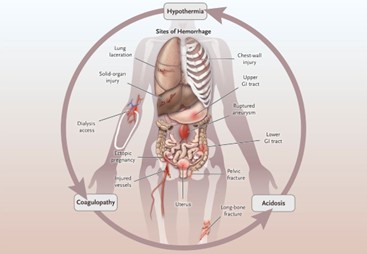The emergency department nurse reviews the medical record of a 41-year-old male patient with hemorrhagic shock, which contains the following information.
Physical Assessment Findings Pulse 140 beats/min and thready
Diagnostic Findings ABG respiratory acidosis
Blood pressure 60/40 mm Hg Respirations 40/min and shallow
Lactate level 7 mmol/L
All of these provider prescriptions are ordered for the patient. Which does the nurse carry out first?
Give Plasmanate 1 unit now.
Prepare for endotracheal intubation.
Give normal saline solution 250 mL/hr.
Type and crossmatch for 4 units of packed red blood cells (PRBCs).
The Correct Answer is C
Hemorrhagic shock is characterized by severe blood loss, leading to inadequate tissue perfusion and hypovolemia. The primary goal in the initial management of hemorrhagic shock is to restore intravascular volume and improve tissue perfusion. Administering intravenous fluids, such as normal saline solution, is a critical intervention to address hypovolemia and improve blood pressure.
A. Give Plasmanate 1 unit now in (option A) is incorrect because: Plasmanate is a plasma-derived product used to replace coagulation factors. While it may be necessary to address coagulation abnormalities, administering intravenous fluids to restore volume takes priority over specific blood products.
B. Prepare for endotracheal intubation in (option B) is incorrect because Endotracheal intubation may be required in cases of impending respiratory failure or compromised airway, but it should not be the first action in addressing hypovolemic shock.
D. Type and crossmatch for 4 units of packed red blood cells (PRBCs) in (option D) is incorrect because transferring packed red blood cells is an important intervention to address blood loss and improve oxygen-carrying capacity. However, before administering blood products, it is crucial to stabilize the patient's hemodynamics through fluid resuscitation.
Therefore, in a patient with hemorrhagic shock, the nurse's first priority among the given options is to give normal saline solution of 250 mL/hr to restore intravascular volume and improve tissue perfusion.

Nursing Test Bank
Naxlex Comprehensive Predictor Exams
Related Questions
Correct Answer is C
Explanation
This method, known as the 6-second method, involves counting the number of QRS complexes in a 6-second interval on the electrocardiogram (ECG) strip and then multiplying that number by 10 to calculate the heart rate per minute. The advantage of this method is that it provides a relatively quick estimate of the heart rate.
A. Printing a 1-minute ECG strip and counting the number of QRS complexes in (option A) is incorrect because it can be time-consuming and may not be practical in situations where a quick estimate is needed.
B. Calculating the number of small squares between one QRS complex and the next and dividing into 1500 in (option B) is incorrect because it is a method used to calculate heart rate, known as the "1500 method," but it is not as quick as the 6-second method and requires more time and measurement precision.
D. Counting the number of large squares in the R-R interval and dividing by 300 is another method used to calculate heart rate, known as the "300 method," but it is also less quick and less accurate for assessing heart rate in patients with regular rhythms.
It's important to note that if the heart rhythm is irregular, these methods may not provide an accurate estimate of the heart rate, and a longer monitoring period or a different approach may be necessary.
Correct Answer is ["A","B","C","D"]
Explanation
These conditions can lead to fluid loss, either through increased gastrointestinal output (diarrhea, vomiting, lower GI bleeding) or accumulation of air in the pleural space (tension pneumothorax), resulting in a decrease in blood volume and subsequent hypovolemic shock.
E. Diabetes insipidus in (option E) is incorrect because it is not directly associated with hypovolemic shock. Diabetes insipidus is a condition characterized by excessive thirst and the production of large volumes of dilute urine due to insufficient production or response to antidiuretic hormone (ADH). While diabetes insipidus can lead to dehydration and potential hypovolemia, it is not a direct cause of hypovolemic shock.
F. Valvular stenosis in (option F) is incorrect because it is a condition characterized by the narrowing or obstruction of one or more heart valves. While it can cause problems with cardiac output and circulation, it is not specifically related to hypovolemic shock, which is caused by a decrease in blood volume.
Therefore, the conditions that can cause hypovolemic shock include diarrhea, vomiting, lower GI bleeding, and tension pneumothorax.
Whether you are a student looking to ace your exams or a practicing nurse seeking to enhance your expertise , our nursing education contents will empower you with the confidence and competence to make a difference in the lives of patients and become a respected leader in the healthcare field.
Visit Naxlex, invest in your future and unlock endless possibilities with our unparalleled nursing education contents today
Report Wrong Answer on the Current Question
Do you disagree with the answer? If yes, what is your expected answer? Explain.
Kindly be descriptive with the issue you are facing.
